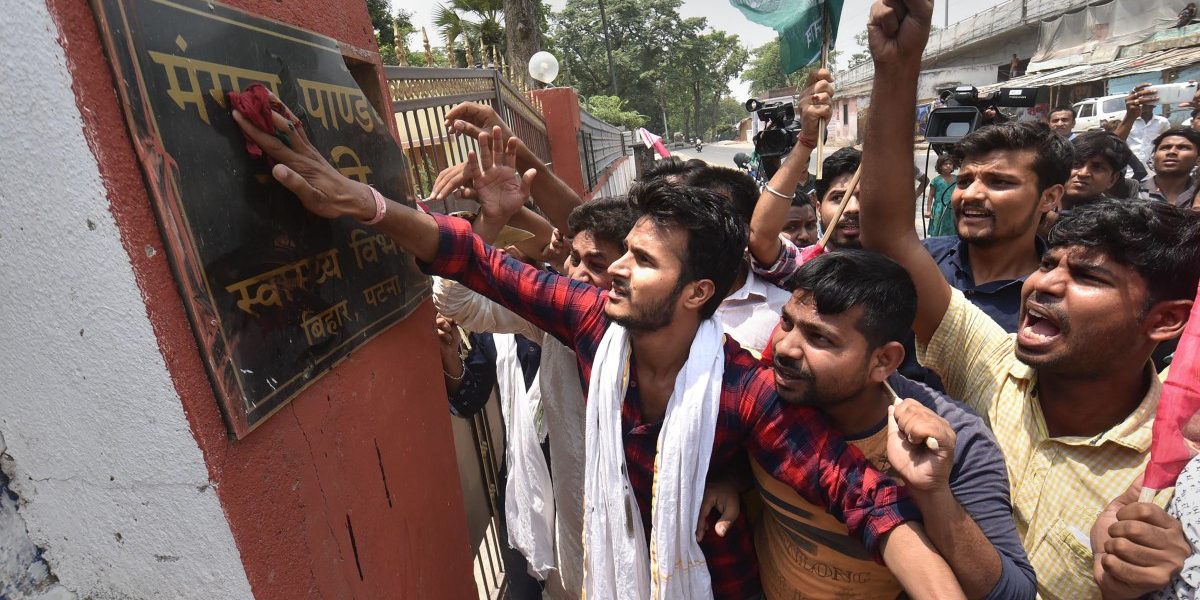
Bihar is currently facing an extreme healthcare crisis, which has seen the deaths of 126 children due to Acute Encephalitis Syndrome (AES) with 418 more admitted at hospitals with complaints of the same.
On Tuesday morning (17 days after the outbreak), the Chief Minister Nitish Kumar visited the Shri Krishna Medical College and Hospital (SKMCH) in Muzaffarpur, where more than 300 children were admitted with complaints of AES since June 1st and close to 90 had died. He was greeted with protests from relatives and parents of the children who were holding up slogans such as "CM wapis jao".
The Acute Encephalitis Syndrome outbreak came at a difficult time for the state, as more than 12,000 doctors from the Indian Medical Association (IMA) there went on strike for 24 hours from Monday to Tuesday.
What is Acute Encephalitis Syndrome?
The WHO defines a case of Acute Encephalitis Syndrome as a person of any age, at any time of the year, who has an acute onset of fever and a change in mental status - with symptoms ranging from confusion, disorientation, paralysis, seizures, coma or the inability to talk. It is characterised by high fevers that alter consciousness and mostly affect children below the age of 15. Treatments include antiviral medication, as well as plenty of fluids and glucose.
Acute Encephalitis Syndrome has taken the lives of over 2000 children in Muzaffarpur between 2000 to 2019. Most of the children affected came from the impoverished Mahadalit community which includes Musahars and scheduled castes. In comparison to the children affected in rural areas, in the past two decades, there have been barely 4 cases of AES in urban pockets.
The cause of Acute Encephalitis Syndrome in Bihar has eluded researchers, but experts say a deadly cocktail of heatwave, malnourishment and binging on lychees on an empty stomach could be the cause. The state's problem has been aggravated due to an acute shortage of doctors, unavailability of key medicines, and lack of nursing staff and beds.
Malnourished children in villages spend most of their days eating litchis from nearby orchards, often skipping dinner or any meal, which leads to an alarming drop in their blood sugar levels. Litchis contain MCPG, which sever the body's ability to synthesise sugar and forces the body to metabolise fatty acids to boost glucose levels. This, in turn, leads to hypoglycaemia and brain fever.
Who is accountable?
Given the limited resources that the state has allotted to healthcare, the inflow of patients at the time of outbreaks and epidemics makes the management of diseases worse, leading to higher casualties. The crisis has been amplified because the state's healthcare mechanisms have failed on several levels from making sure the children have basic nutrition, to providing satisfactory treatment at hospitals.
The lax manner in which politicians are handling the outbreak of this epidemic has also been shameful and downright appalling. Union Minister Ashwini Kumar Choubey was caught napping during a press meet on encephalitis on last Sunday, while Bihar's Health Minister Mangal Pandey drew widespread criticism for enquiring about an ongoing cricket match score at another event held for AES on the same day.
Ajay Nishad a Muzaffarpur parliamentarian was quoted attributing the viral outbreak to a deadly combination of four Gs that plague the state saying "encephalitis, as you know, is caused by garmi (heat), gandhagi (unhygienic conditions), garibi (poverty) and gaon (villages)."
The Shri Krishna Medical College and Hospital (SKMCH) in Muzaffarpur in Muzaffarpur is a prime example of the "gandhagi" that plagues hospitals in rural areas all over the country. There is garbage dumped all over the hospital and it has become a breeding ground for mosquitoes while over 300 kids are being treated within the premises.
Advocate Manohar Pratap filed a writ petition at the Supreme Court over the deaths of the children. He claimed that the deaths are a direct result of the negligence and inaction on the part of the respective state governments of Bihar, Uttar Pradesh and the Union of India in handling the epidemic situation which arises each year due to the outbreak of AES.
The Supreme Court on Wednesday decided to hear the writ petition, with a vacation bench of justices Deepak Gupta and Surya Kant agreeing to hear the plea on Monday, June 24th after the petitioner’s counsel sought an urgent listing of the matter.
Social activist Tamanna Hashmi also filed a complaint case against Union Health Minister Dr. Harsh Vardhan and state health minister Mangal Pandey in a Muzaffarpur court on Monday, charging them with negligence that leads to the children's deaths.
Doctor's Strike and India's Health Care Crisis
This past week was characterised by a major crisis in hospitals and health care facilities all over the country. In Bihar and Uttar Pradesh, the AES outbreak has shed light on the inefficiency of our health care system. with the hospitals in the rural parts of these states characterised by unhygienic conditions, lack of infrastructure, lack of medicine and under-qualified doctors.
To add to the problems in Bihar, the country-wide strike, called by Indian Medical Association (IMA) over the assault of 2 doctors in West Bengal was supported by the Bihar State Health Services Association paralysing the states healthcare facilities. Long queues of hapless patients were seen at PMCH in Patna, the largest hospital in the state while OPDs remained completely suspended, though the Bihar State Health Services Association ensured that critical patients and children were still treated.
The National Human Rights Commission (NHRC) on Monday sent notices to the Union Health Ministry and the Government of Bihar seeking a detailed report on the steps taken to deal with this painful situation. Both the Bihar Chief Minister Nitish Kumar and Union Health Minister Dr. Harsh Vardhan have come under heavy criticism, with no end to the crisis in sight.
- Khrish Shahani


